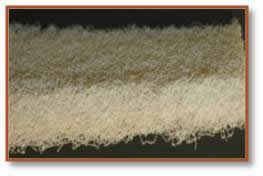 It has been recognized since at least the early 1980’s (ref. G.P. Raymond, “Railway Rehabilitation Geotextiles”) that applying non-water soluble synthetic resin to mechanically-bonded needlepunched geotextiles can provide benefit by providing added abrasion resistance to fabrics used below rail track ballast for subgrade – ballast separation, i.e. acrylic-based resins with heavy weight polyester fiber geotextiles.
It has been recognized since at least the early 1980’s (ref. G.P. Raymond, “Railway Rehabilitation Geotextiles”) that applying non-water soluble synthetic resin to mechanically-bonded needlepunched geotextiles can provide benefit by providing added abrasion resistance to fabrics used below rail track ballast for subgrade – ballast separation, i.e. acrylic-based resins with heavy weight polyester fiber geotextiles.
The use of purely resin-bonded geotexiles has thus far seen limited use (e.g. as Class IV Geotextiles per National Engineering Handbook guidelines) with the application of resin-bonded textiles as golf course bunker (a.k.a. ‘sand-trap’) ‘liners’ in the golf industry a notable example (ref. C. Mills, “Geosynthetic Bunker Liners: A Proposed Design Methodology for Golf Course Improvement”). The niche application of resin-bonded synthetic-fiber textiles used to provide slope stability and drainage improvement as golf course bunker liners has been successful due to the inherent nature of the environment involved; i.e. the need for a geosynthetic to provide very high permeability and long-term durability in a moist and abrasive environment and with relatively low loading (i.e. ‹ 5 kPa).
Resin-bonded textiles are typically ‘thick’ (e.g. routinely in the range of 10 mm to 25 mm but up to 75 mm being possible) and usually quite compressible materials (e.g. an initially 25 mm thick, resin-bonded textile may reduce to 67% to 75% of its original thickness under a load of 2.5 kPa). Resin-bonded textiles can be made with a wide range of fiber diameters (e.g. from 6 denier to 200 denier or more) that can create fabrics with very ‘open’, porous structures possessing very high drainage capabilities (e.g. permeability 2.0 to 5.0 cm/sec., permittivity 2.0 to 3.0 sec-1, etc.). The nature of the manufacturing processes offer flexibility in fiber web orientation and variations in the resins (e.g. acrylics, acetates, PVC’s, etc.) and fibers used (polyester, nylon, etc.), all of which can result in a range of value added attributes and features for final products; such as flammability, porosity, stiffness, flexibility, color, etc.
It is also possible to introduce specialized additives to the basic resin chemistry to provide improved resistance to U.V. light, moisture, chemical and biological activity, etc. So, for the design engineer, it raises the interesting potential of being able to reduce or possibly eliminate the reduction factor (RF) associated with biological clogging as might normally be used for (low-load) underdrain filters, erosion control filters or landfill cap filter applications, sports fields, retaining walls, plaza decks, etc. (ref. R. Koerner et al., “Reduction Factors (RF’s) Used in Geosynthetic Design”).
It is speculated that the relatively thick and ‘wiry’ nature of the fiber matrix formed by resin-bonding fibers may also create a geotextile ‘blanket’ ideal for sediment entrapment, e.g. in shallow channels, adjacent to inlet structures, downstream of geotextile ‘tubes’, etc. The use of hydrophilic resins in the textile manufacturing process, may produce textiles used to enhance moisture retention in grass paving applications, etc. It is in these arenas that resin-bonded geotextiles may finally find other true niches beyond golf course bunker liners.
Clive W. Mills is the market development manager for Fiber Bond Corporation, http://www.fiberbond.net.











